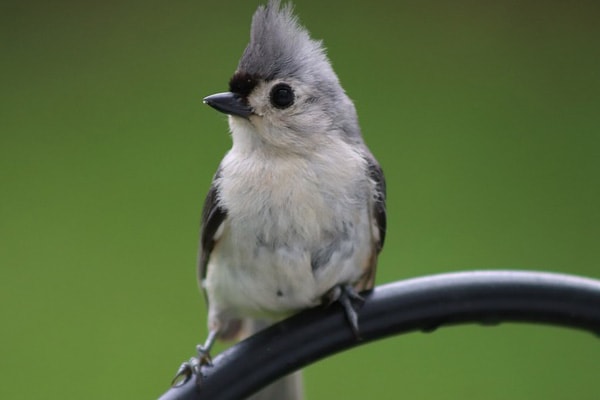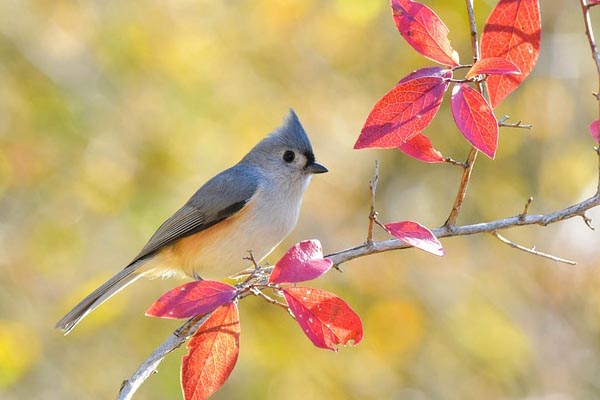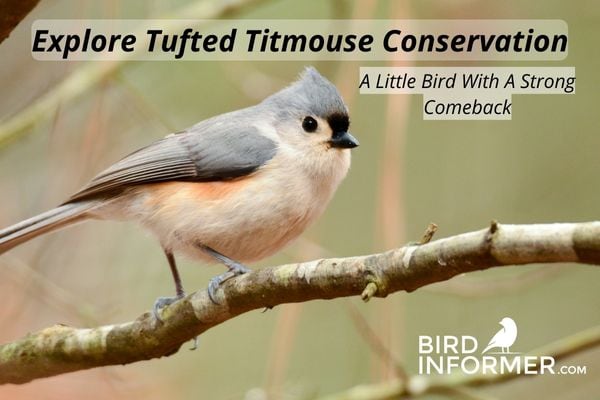Contents
The tufted titmouse is a relatively small, grey songbird found in the heart of North America. This common bird was one struggling from population decline, but its population has seen increases for a 49-year stretch due to effective conservation efforts.
According to Wikipedia,
From 1966 to 2015, the tufted titmouse population has increased by more than 1.5% per year throughout the northeastern US. The current breeding population is estimated to be approximately 8 million.
It shouldn’t surprise anyone to hear that this bird’s conservation status is considered Least Concern. But things are, unfortunately, starting to change. Over the last eight years, the population is beginning to decline ever so slightly.
What changed? What has happened to cause the tufted titmouse to experience population decline over the last near-decade?
Even though this bird has a lasting presence spread throughout the northeastern and eastern parts of the United States, its population has begun to diminish recently due to climate change and habitat loss.
These two scenarios are the reason why various avian creatures and other animals are experiencing population decline around the globe. We must work together to overcome these challenges and protect the tufted titmouse population to prevent its decline and ultimate demise.
Right now, there are numerous conservation efforts underway to keep tufted titmouse populations growing strong to ensure their continued survival for future generations to come. The efforts taking place include:
- Preservation of natural habitats
- Restoration of natural habitats
- Creating additional nesting sites with artificial nest boxes
- Learning more about tufted titmouse behavior and biology to improve conservation efforts and strategies
Are you ready to learn more about the tufted titmouse population? Are you ready to learn about the conservation efforts taking place to preserve the species? Keep reading to discover their current status, conservation efforts, nest box programs, education, and much more.
Current Conservation Status of the Tufted Titmouse Population
As mentioned earlier, the current status of the tufted titmouse population is considered Least Concern. According to All About Birds, “Tufted titmice are common, and populations have increased between 1996 and 2019, according to the North American Breeding Bird Survey.”
Their information differs a bit from Wikipedia. Partners in Flight currently estimate that there are 12 million tufted titmice birds as part of the global breeding population. They also give this bird species a 7 out of 20 based on the Continental Concern Score. Ultimately, this indicates that the tufted titmouse species isn’t a major conservation concern since they spent roughly 50 years expanding northward.
In Maine, for example, the tufted titmouse now has a presence within the state. This was unheard of in the 1950s, but due to climate change and global warming, these birds are beginning to migrate north to avoid the heat. Many believe that farmlands reverting to forests, a warming climate and backyard bird feeder popularity are major reasons why these birds are expanding Northeast in the United States in places like Maine.
According to News Center Maine, “Of course, as birds that are well established in Maine move northward, birds that have no history in Maine will start one. One example, Hitchcock said, is the tufted titmouse, a bird species almost never seen in Maine in the 1950s but now a growing population, possibly because of a warming climate.” Mr. Hitchcock believes other bird species will also move to Maine due to climate change and a warming planet.
With that said, let’s take a closer look at the main problems that the tufted titmouse population will face if conservation efforts are unsuccessful.
Habitat Loss and Fragmentation
You can mainly find the tufted titmouse within deciduous forests throughout the eastern part of the United States. Nevertheless, their population has begun to suffer some declines due to habitat loss and fragmentation and the impact that it has had. This mostly happens because of certain human activities. They include:
- Urbanization
- Deforestation
- Agriculture
- Oil and Gas Development
- Using Pesticides and Herbicides
As a result of human activities, the species has begun to decline steadily over the last few years. These population declines are more noticeable in certain areas. In particular, as the climate warms up, tufted titmice are beginning to migrate north into cooler climates.
Habitat loss and fragmentation will have a negative impact on tufted titmice in a number of ways. These impacts include:
- Increased predation – when habitats are fragmented or completely lost, the tufted titmouse becomes much more vulnerable to potential predators. Why? They have fewer places to hide and even fewer places to escape from these dangerous predators.
- Decreased genetic diversity – when habitats become lost or fragmented, tufted titmice may suffer from decreased genetic diversity. This could potentially lead to threats, including becoming more susceptible to certain diseases.
- Less breeding success – when habitats become fragmented or lost, it becomes much harder for tufted titmice to initiate successful breeding activities. This happens because there are fewer places available to find food and build nests for their new young family.
- Less available food – like the other issues faced due to habitat fragmentation and habitat loss, the potential for reduced food availability is a major threat. Why? When their habitat becomes destroyed, there is a lot less food available, and it becomes a lot harder to find. This will lead to malnutrition and starvation.
Climate Change
Speaking of cooler climates…
Climate change has already begun to have a significant impact on the population of tufted titmice across the United States. While this species has thrived in temperate climates and has adapted to them, it’s certainly going to potentially struggle in areas with predicted weather patterns and extreme temperatures, which is a direct result of climate change.
Furthermore, the precipitation pattern changes that are happening could have a negative impact on food source availability for these birds.
Predation and Competition
It shouldn’t shock anyone to learn that predation and competition are also major factors that have an impact on the total number of tufted titmouse population still in existence. Snakes and squirrels are definitely nest predators that can reduce their breeding success. Other bird species might limit population growth due to competition when they begin competing for their nesting sites and food.
Even though these particular challenges are taking place, there are conservation efforts underway that provide protection and habitat restoration to help stabilize the overall population of the tufted titmouse in certain areas. More ongoing research and monitoring are also required to get a better understanding of this species, to learn more about their wants and needs, and to help develop effective strategies for conservation.
Conservation Efforts for Tufted Titmice

Thankfully, there are many wonderful people and organizations designed to help these diminutive birds maintain their thriving population. Some of the major areas of focus include the following:
- Habitat Conservation and Restoration
- Nest Box Programs
- Education and Outreach Programs
- Monitoring and Research Programs
Without any further ado, let’s look at each of these areas in greater detail below.
Habitat and Conservation-Restoration
According to the National Audubon Society, the tufted titmouse lives
…mostly in deciduous forest with tall trees, sometimes in mixed forest. Can live in orchards, suburbs, or even city parks if trees are large enough.
As you can see, these birds require special conditions in their habitat if they’re going to survive and thrive. In particular, they truly thrive in deciduous forests with a mix of different trees, snags, and understory vegetation.
Urbanization, forest management practices, and land-use changes are all responsible for habitat loss and fragmentation. They will have a negative impact on the tufted titmouse population.
Right now, conservation efforts are underway that focus on restoring and protecting suitable habitats through conservation agreements, easements, and land acquisition.
Moreover, understory enhancement and reforestation habitat restoration projects are being implemented, which will improve the overall connectivity and quality of the habitat.
Nest Box Programs
Believe it or not, nest box programs are springing up all over the United States that are helping to successfully increase the populations of tufted titmice in specific areas that are limited or absent of natural cavities.
These programs are incredibly important. They help by installing and moderating nest boxes in habitats in environments that are perfectly suitable for these birds.
What do the boxes do?
The boxes will serve a great purpose by providing nesting sites, for one. But they also serve as an incredible tool for monitoring and research because cameras can be placed inside the nesting boxes to learn much more about tufted titmice during the breeding process.
More often than not, the nest box programs are implemented by citizen scientists, landowners, and organizations.
Do you live anywhere near a deciduous forest? Are you thinking about putting up a nesting box in your backyard or somewhere on your property? Consider the following from Nest Watch:, After you’ve successfully built a nest box,
Place the nest box in an area with large, deciduous trees. Favorable habitats include forests, parks, and suburban neighborhoods with mature trees.
Education and Outreach Programs
In an effort to increase public awareness, many bird-watching groups and conservation agencies provide education and outreach programs about tufted titmouse conservation efforts.
How do they design these programs?
More often than not, these programs will consist of field trips, presentations, and workshops designed to educate the public about habitat conservation and its importance. It will also promote nest box programs and citizen science initiatives.
Even more importantly, they’ll share brochures and other educational materials with anyone interested in learning about these educational and outreach programs. They will share them with the public to teach them about the importance of tufted titmice and their conservation needs.
Monitoring and Research Programs
Monitoring and research programs are also critical pieces of the puzzle that will help us better understand tufted titmouse population trends and their status. These programs will definitely help to keep our conservation efforts informed and heading in the right direction.
In particular, these monitoring and research programs usually involve the following activities:
- Collecting data on population size
- Gathering data on population demographics
- Collecting data on population distribution
- Gathering data on habitat use and habitat quality
- Investigating the effects of habitat disturbances
- Researching the effects of climate change
- Investigating the effects of environmental stressors on tufted titmice
Government agencies, academic institutions, and conservation organizations are typically responsible for the most prevalent and successful monitoring and researching programs in the United States.
Conservation Challenges & Descriptions
| Challenge | Description |
|---|---|
| Habitat loss | Losing natural habitats is one of the biggest threats to biodiversity. This loss is typically caused by a few consistent factors including climate change, urbanization, deforestation, and agriculture. |
| Overexploitation | Overexploitation is particularly insidious because it means we are using natural resources at such incredibly fast rates that we cannot replenish them quick enough. This tends to deplete animal and plant populations, which often leads to extinction. |
| Invasive species | Non-invasive and invasive species can be introduced into areas where they aren’t naturally present. These unwelcome species sometimes outcompete with tufted titmice and take all of the resources for themselves, which could potentially lead to extinction as well. |
| Pollution | Pollution is a major conservation challenge because it causes great harm to animals and plants in many different ways. Some include contaminating air, soil, and water, which directly harms all organisms. |
| Climate change | Climate change is when there are long-term changes taking place on the earth and its climate. This can lead to changes and rising sea levels, precipitation, and temperature changes. They often have a significant impact on the plants and animals populating the earth, which can cause serious harm and potentially lead to the tufted titmouse population eventually becoming extinct. |
Conservation Efforts: Challenges and Future Directions

The success of future conservation efforts relies on facing challenges head-on and implementing plans and future directions that will benefit tufted titmice to help preserve and protect this thriving species. It makes sense to begin conservation efforts now while the population is still plentiful but beginning to decline.
The areas to focus on to overcome challenges and determine the future direction of tufted titmice conservation include the following:
- Funding and resources
- Collaboration and partnership
- Adaptive management and conservation planning
Funding and Resources
Conservation efforts will have a difficult time succeeding if they do not have the proper funding and resources available to help them thrive. This is one of the biggest challenges for all tufted titmouse conservation efforts. Considering the species is critical, yet it requires significant resources. They include:
- Habitat management
- Research
- Monitoring
Like most things in this life, funding for conservation efforts is typically limited, and competition for these resources is quite high. That’s why it’s often tough to effectively implement conservation measures, but we will continue to work hard and spread awareness to achieve our goals.
In fact, the best way to face this challenge head-on and address it successfully is to work diligently to secure long-term funding and resources to improve conservation efforts. This is often achieved by partnering with nonprofits, government agencies, and private donors that care about the health and well-being of tufted titmice.
Prioritizing and allocating resources strategically is also critically important and will have the biggest impact on your conservation efforts as well.
Collaboration and Partnership
Tufted titmouse conservation efforts will only be as successful as their collaborations and partnerships. This little bird inhabits a wide range of different ecosystems and habitats, so conservation efforts will require a coordinated effort. In fact, private landowners, academic institutions, nonprofit organizations, and government agencies must all do their part in order to achieve worthwhile conservation goals.
Clear communication channels are necessary to foster partnerships and collaborations. They must develop shared goals and objectives and work together to achieve them. Getting stakeholders in conservation efforts and local communities involved is also essential and requires their support and participation to succeed.
Adaptive Management and Conservation Planning
To keep long-term conservation efforts underway and successful, adaptive management and conservation planning are an absolute must to help save the tufted titmouse. Just like any other conservation effort, there is a need for continual monitoring and evaluation to determine the effectiveness of the conservation efforts being undertaken. We must measure the success of our efforts and make changes and adaptations when necessary.
For this to be possible, comprehensive conservation plans must be adapted and followed through upon. We need clear, measurable outcomes, objectives, and goals.
For example, one goal could be to add 100 new nesting boxes to deciduous forest areas that the tufted titmouse calls home. Add these nest boxes to ensure that the tufted titmouse populations survive and thrive while ensuring that their breeding efforts are successful.
Then, when all is said and done, we should measure the success of these nesting boxes to find out if they are effective. Each nest box should have a camera inside recording 24 hours a day. This will let us know if a tufted titmouse couple took over the nesting boxes and hatched new younglings. If not, then we can reevaluate our efforts, possibly move the nesting boxes to a new location, and make adjustments on the fly.
Final Thoughts on Tufted Titmouse Conservation Efforts
Today, we learned a great deal about tufted titmouse conservation efforts and the challenges that we face implementing these necessary plans. To recap, some of the main areas that we discussed today include:
- Conservation status and potential areas affecting their health and longevity, including climate change, habitat loss and fragmentation, and predation and competition
- Conservation efforts, including habitat conservation and restoration, nest box programs, education and outreach programs, and monitoring and research programs
- Challenges and the future direction of conservation, including funding and resources, collaboration and partnership, and adaptive management and conservation planning
Please do your part to preserve and protect the tufted titmouse population. They really need your help. So, get involved with local conservation efforts in your area. Actively donate your time, money, and energy to this cause.
Please remember to educate others about the plight of tufted titmice and other bird species suffering from climate change, agricultural change, deforestation, and other issues harming their habitats.

